Barber J.R. Intermediate Mechanics of Materials
Подождите немного. Документ загружается.

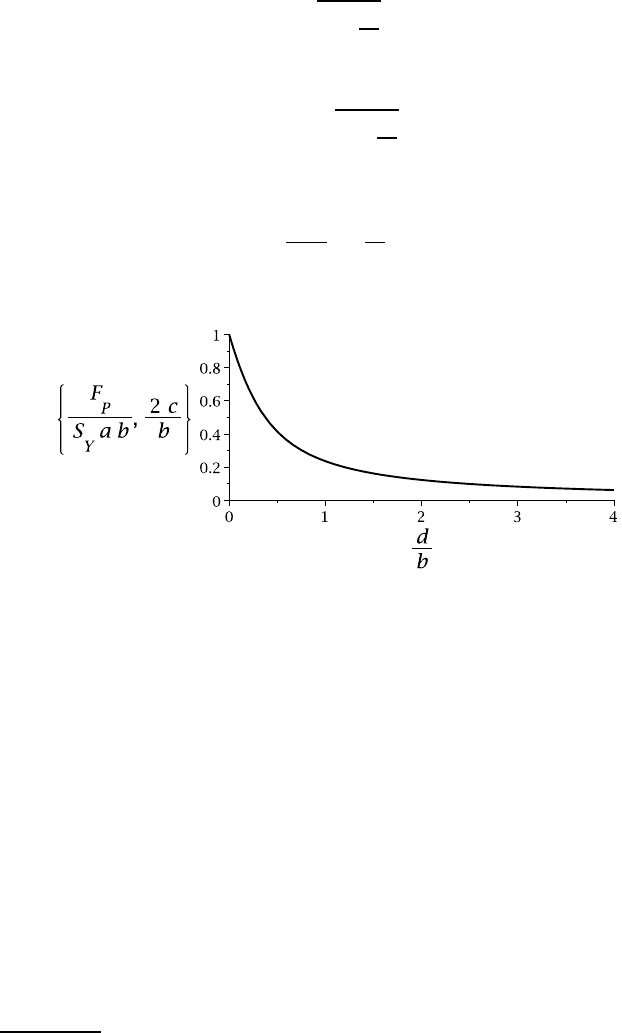
5.5 Bending of a symmetric section about an orthogonal axis 255
c = ±
r
d
2
+
b
2
4
−d .
If d > 0, only the positive square root
2
gives a physically reasonable result. For
this case,
F
P
= 2S
Y
a
r
d
2
+
b
2
4
−d
!
.
The dimensionless quantities
F
P
S
Y
ab
;
2c
b
both vary with the load offset d as shown in Figure 5.17.
Figure 5.17
Notice that when d =0, there is no offset of the load and we obtain c=b/2, which
identifies the neutral axis with the lower edge of the cross section. This simply means
that the whole section is above the neutral axis and hence is yielding in tension at
σ
zz
=S
Y
, leading to a collapse load, F
P
=S
Y
ab.
For any non-zero value of d, however small, c will be less than b/2 and there will
be a region of compressive stress below the neutral axis.
5.5.3 The partially plastic solution
The problem of determining the stress field for applied moments between M
Y
and
M
P
is rather more complicated. We first note that the beam will remain elastic as
long as
σ
zz
=My/I <S
Y
for all values of y, measured from the centroidal axis. When
this condition is violated, yield will start at the point in the section where |y| is a
maximum and this will generally be on one side of the axis only, since the section is
unsymmetrical. This plastic zone will grow with M until at some intermediate value
a second plastic zone initiates on the other side of the axis. Both zones then grow at
2
For d < 0, we would need to take the negative square root, but the solution would merely
be a mirror image of that given here.
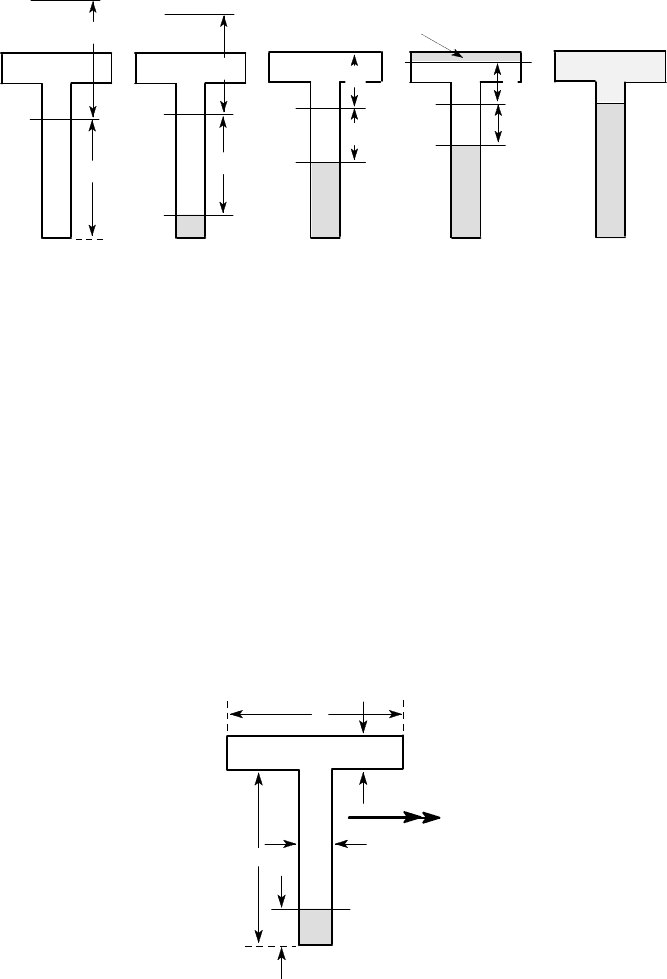
256 5 Non-linear and Elastic-Plastic Bending
the expense of the elastic zone until eventually the section becomes fully plastic at
M
P
.
.
C
d
d
E
E
.
C
d
E
E
P
d
.
C
d
E
P
d
.
C
E
P
d
d
P
.
C
P
P
S
Y
-S
Y
(a) (b) (c) (d) (e)
Figure 5.18: Development of plastic zones for a symmetric section bent about an
orthogonal axis: (a) first yield, (b) one plastic zone, (c) initiation of yield at top of
section, (d) two plastic zones, (e) full plasticity
This process is illustrated by the sequence of Figures 5.18 (a–e). Notice how the
plastic zones develop and also how the neutral axis moves away from the centroid C
as the moment is increased. Throughout the process, the position of the neutral axis
and the dimension d are determined in terms of the force F and the moment M
x
using
the first two of equations (5.16).
Example 5. 6
The T-beam of Figure 5.19 is loaded by a bending moment about the x-axis. Find an
equation relating the bending moment M and the dimension c defining the extent of
the plastic zone for the case illustrated where there is only one plastic zone. Also,
find the value of c at which a second plastic zone will start to develop at the top of
the section. The material yields at constant yield stress ±S
Y
.
E
P
c
a
a
b
b
M
Figure 5.19

5.5 Bending of a symmetric section about an orthogonal axis 257
Since we don’t yet know the location of the neutral axis, it is convenient to take
the origin at the bottom of the section as shown in Figure 5.20 (a). The material has
yielded in compression (
σ
zz
= −S
Y
) in 0 < y < c and the stress must vary linearly in
the elastic range as shown in Figure 5.20 (b). Thus
σ
zz
= −S
Y
; 0 < y < c
= −S
Y
+C(y −c) ; c < y < a + b ,
where C is a constant to be determined. Notice how the second expression satisfies
the condition that the stress in the elastic region just above y = c should be on the
point of yielding — in other words, the stress is a continuous function of y.
c
a
a
b
b
M
y
c
a
a+b
O
σ
zz
-S
Y
y
O
x
(a) (b)
Figure 5.20
We can determine the value of C from the condition that the total axial force be
zero. From the first of (5.16), we have
F =
ZZ
A
σ
zz
dA = −S
Y
bc +
Z
a
c
[−S
Y
+C(y −c)]bdy +
Z
a+b
a
[−S
Y
+C(y −c)]ady .
Performing the integrals and simplifying, we find
F = −2abS
Y
+
Cb
2
(3a
2
+ ab + c
2
−4ac) = 0
and hence
C =
4aS
Y
3a
2
+ ab + c
2
−4ac
.
The neutral axis corresponds to the point y= y
0
, where
σ
zz
=0 and hence
−S
Y
+C(y
0
−c) = 0 .
Solving for y
0
and using the above value of C, we obtain

258 5 Non-linear and Elastic-Plastic Bending
y
0
= c +
S
Y
C
= c +
3a
2
+ ab + c
2
−4ac
4a
=
3a
2
+ ab + c
2
4a
.
The moment corresponding to this stress distribution can be found by taking
moments about any convenient horizontal axis, since there is no axial force F. Thus,
using the axis y= 0 of Figure 5.20 (a), we have
M =
ZZ
A
σ
zz
ydA =
Z
c
0
(−S
Y
)ybdy +
Z
a
c
[−S
Y
+C(y −c)]bydy
+
Z
a+b
a
[−S
Y
+C(y −c)]aydy .
After performing the integrals and substituting for C, we find
M =
S
Y
ab(5a
3
+ 6a
2
b + 12a
2
c + 5ab
2
−9ac
2
−3bc
2
+ 4c
3
−12abc)
6(3a
2
+ ab + c
2
−4ac)
.
This is the required relation between M and c.
The second plastic zone will start when
σ
zz
=S
Y
at y =a + b — i.e.
−S
Y
+C(a + b −c) = S
Y
.
Substituting for C and simplifying, we obtain
a
2
−ab + c
2
−2ac = 0 ,
with solution
c = a ±
q
a
2
−(a
2
−ab) = a ±
√
ab .
Only the negative square root makes sense here, so yield at the top of the section
starts when
c = a −
√
ab .
It is clear from this example that the process is algebraically very complicated,
even for a relatively simple beam section. The second stage of the process, where
there are two plastic zones is equally complicated. The chances of making an al-
gebraic error in such calculations is so large that they are only really practicable
if performed symbolically using a language such as Mathematica or Maple or im-
plemented numerically. Fortunately most of the important information for design
against failure can be extracted from the limiting cases of first yield and full plas-
ticity, which we have seen are easier to compute. The exception is the problem of
residual stress and springback, which we discuss in §5.7 below and which unfortu-
nately requires a solution for the stress field at the maximum applied load.
5.6 Unsymmetrical plastic bending
If the beam section has no axis of symmetry or if the bending moment is applied
about an inclined axis, the problem is even more complicated and generally neces-
sitates a numerical solution. However, the limiting solutions for first yield and full
plasticity are still approachable algebraically.

5.6 Unsymmetrical plastic bending 259
For first yield, we perform an elastic analysis, using the techniques of Chapter
4. After finding the location and magnitude of the maximum stress
σ
max
, the yield
moment M
Y
can then be determined by equating
σ
max
to ±S
Y
as appropriate.
For full plasticity, we know that the neutral axis will divide the section into two
equal areas of tensile and compressive yield respectively, if there is no axial force.
Because of the lack of symmetry, we do not know the inclination of the neutral axis,
but we can obtain an equation to determine it by requiring that the resultant plastic
moment be about the specified bending axis. One way to implement this condition
is to take moments about an axis perpendicular to the applied moment axis and set
the resultant to zero. This procedure leads to manageable algebraic calculations for
thin-walled sections and for some other simple geometries.
Example 5. 7
A beam of square cross section a×a is subjected to a bending moment about an axis
inclined at an angle
θ
to the horizontal, as shown in Figure 5.21. The moment is
sufficient to cause plastic collapse of the section. Assuming that the neutral axis is
inclined at an angle
α
to the horizontal, find the relation between
α
and
θ
in the
range −
π
/4 <
θ
<
π
/4 and the corresponding value of the fully plastic moment M
P
.
M
y
O
x
a
a
θ
Figure 5.21
The inclined neutral axis must pass through the centre of the square, since any
such line divides the section into two equal areas. If the axis is inclined at an angle
α
, the stress at plastic collapse will be as shown in Figure 5.22 (a).
For the purposes of calculation, it is convenient to consider this as the sum
3
of the
distributions of Figure 5.22 (b,c). The area of each of the triangles in Figure 5.22 (c)
is
A
t
=
1
2
a
2
a
2
tan
α
=
a
2
tan
α
8
3
Notice that this superposition is valid as long as we only use it to calculate force and
moment resultants, but the deformations due to the stress fields of Figure 5.22 (b,c) do not
generally sum to those due to Figure 5.22 (a), since the constitutive law is non-linear.

260 5 Non-linear and Elastic-Plastic Bending
and their centroids are at the points
a
3
,
a tan
α
6
;
−
a
3
,−
a tan
α
6
.
x
α
S
Y
-S
Y
(a)
Y
-S
Y
S
Y
2S
Y
-2S
a tan α
2
a
2
0
0
(b) (c)
Figure 5.22
We can therefore compute the moments about the x and y axes as
M
x
= 2S
Y
(a)
a
2
a
4
−2(2S
Y
)
a
2
tan
α
8
a tan
α
6
= a
3
S
Y
1
4
−
1
12
tan
2
α
M
y
= 2(2S
Y
)
a
2
tan
α
8
a
3
=
a
3
S
Y
tan
α
6
.
The angle of inclination of the applied moment axis can then be written
tan
θ
=
M
y
M
x
=
2tan
α
(3 −tan
2
α
)
,
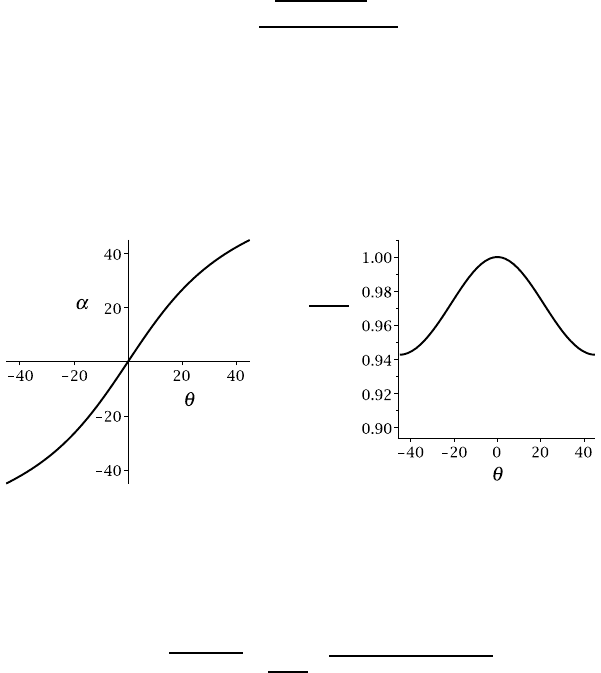
5.6 Unsymmetrical plastic bending 261
with solution
tan
α
=
√
1 + 3 tan
2
θ
−1
tan
θ
.
This is the required relation between
α
and
θ
. It is valid only in the range −
π
/4 <
α
<−
π
/4, since beyond this range the neutral axis will intersect the top and bottom
of the section rather than the sides. However, the same result can be extended into
other ranges by rotating the figure through 90
o
.
The variation of
α
with
θ
(in degrees) is illustrated in Figure 5.23 (a). Notice that
α
=
θ
at
θ
=−
π
/4, 0,
π
/4 etc. due to symmetry.
4M
P
a
3
S
Y
(a) (b)
Figure 5.23
The resultant fully plastic moment is
M
P
=
q
M
2
x
+ M
2
y
=
a
3
S
Y
12
p
9 −2 tan
2
α
+ tan
4
α
.
This expression is shown in Figure 5.23 (b). The moment M
P
varies between a max-
imum of 0.25a
3
S
Y
at
θ
=0 and a minimum of 0.236a
3
S
Y
at
θ
=±
π
/4.
Example 5. 8
The thin-walled unsymmetrical U-section of Figure 5.24 is loaded by a moment about
the horizontal axis. Find the fully plastic moment M
P
and the inclination of the cor-
responding neutral axis.
There is no axial force and hence the areas above and below the neutral axis must
be equal, giving
(a −d
1
) + (2a −d
2
) = d
1
+ a + d
2
— i.e.
2(d
1
+ d
2
) = 2a .
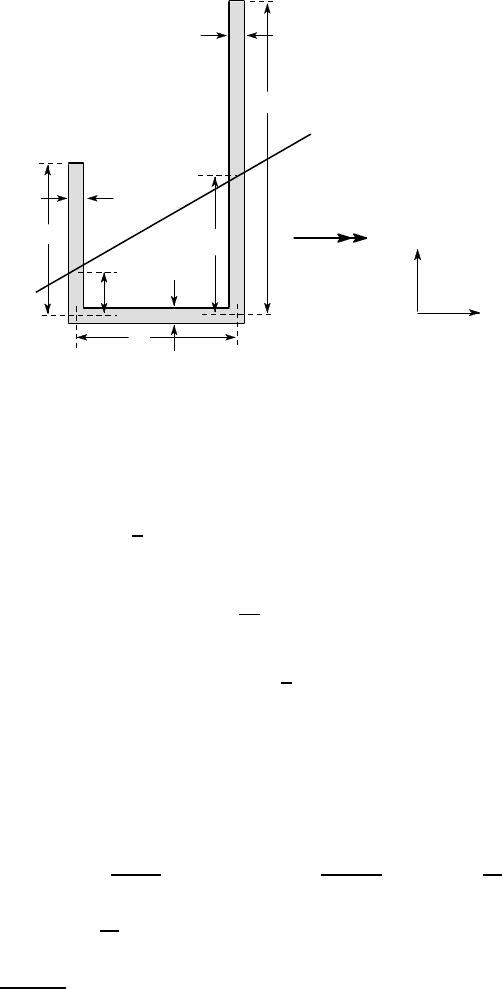
262 5 Non-linear and Elastic-Plastic Bending
t
2a
a
A
B
C
D
E
F
neutral
axis
a
t
t
M
d
1
d
2
x
y
Figure 5.24
Since the moment is applied about the x-axis, the component M
y
must be zero.
It is convenient to enforce this condition by taking moments about a vertical axis
through the point B in Figure 5.24, since then the forces acting on AE and EB have
zero moment arm and make no contribution. We obtain
−S
Y
(at)
a
2
−S
Y
(d
2
t)a + S
Y
(2a −d
2
)ta = 0
— i.e.
d
2
=
3a
4
.
We can then recover d
1
as
d
1
= a −d
2
=
a
4
.
This completes the solution for the neutral axis and shows that the horizontal
bending moment causes the beam to bend about an axis that is inclined at an angle of
tan
−1
(0.5) to the horizontal. The neutral axis also completely defines the stress field
at full yield and the plastic moment can therefore be obtained by taking moments
about the horizontal axis passing through BC, giving
M
P
= S
Y
(a −d
1
)t
a + d
1
2
+ S
Y
(2a −d
2
)t
2a + d
2
2
−S
Y
d
1
t
d
1
2
−S
Y
d
2
t
d
2
2
=
15S
Y
a
2
t
8
,
after substituting for d
1
,d
2
.
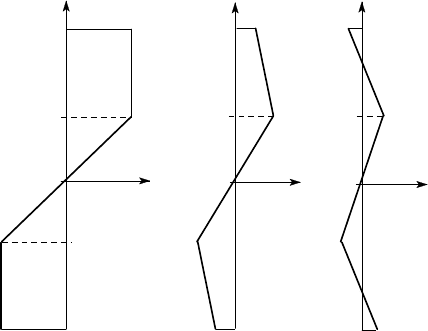
5.7 Unloading, springback and residual stress 263
5.7 Unloading, springback and residual stress
If a beam is loaded into the plastic range and then unloaded, there will be some
permanent residual curvature and the material will be left in a state of residual stress.
We first note that the argument of §5.1 remains valid during the unloading process,
so the strain is at all times a linear function of position in the section. As we start
to reduce the bending moment, the magnitude of the strain will decrease and those
parts of the cross section that have yielded will unload along a parallel elastic line
such as CD in Figures 5.2, 5.3. In most cases, the unloading process is completely
elastic (i.e. no further yield occurs as the bending moment is reduced to zero) and
hence the change in the stress field during unloading is identical to that produced in
a corresponding elastic beam subjected to the same change of bending moment.
Figure 5.25 shows the evolution of the stress distribution for a symmetric beam
bent about an axis of symmetry. We suppose the maximum bending moment M
max
lies in the range M
Y
< M
max
< M
P
, so that the corresponding stress distribution has
the form of Figure 5.25 (a), with plastic zones at the top and bottom of the beam,
separated by a central elastic region of depth 2d. As the moment is reduced, the
strain and hence the stress reduces by an amount proportional to the distance from
the neutral axis, leading to a stress distribution of the form of Figure 5.25 (b). If
the moment is completely removed, the stress distribution must have zero resultant
moment and hence must have regions of tensile and compressive stress on each side
of the neutral axis, as shown in Figure 5.25 (c).
d
d
S
Y
-S
Y
-d
zz
σ
zz
σ
zz
σ
(a) (b) (c)
Figure 5.25: Evolution of the stress distribution during loading and unloading: (a)
maximum load, (b) partial unloading, (c) complete unloading
In algebraic terms, the stress field at M
max
(Figure 5.25 (a)) can be written
σ
zz
= S
Y
; y > d (5.29)

264 5 Non-linear and Elastic-Plastic Bending
=
S
Y
y
d
; −d < y < d (5.30)
= −S
Y
; y < −d (5.31)
and that for any stage of elastic unloading is
σ
zz
= S
Y
−
M
∗
y
I
; y > d (5.32)
=
S
Y
d
−
M
∗
I
y ; −d < y < d (5.33)
= −S
Y
−
M
∗
y
I
; y < −d , (5.34)
where M
∗
= M
max
−M is the reduction in bending moment from the elastic-plastic
state described by equations (5.29–5.31). In the special case of complete unload-
ing [Figure 5.25 (c)], where we reduce the applied moment to zero, M
∗
= M
max
and
hence the residual stress field is the difference between that which is obtained by
elastic-plastic analysis at M
max
and that which would have been obtained at the same
moment (M
max
), if the material had had a sufficiently high yield stress to remain
elastic. Students sometimes have difficulty with this concept, arguing that if the su-
perposed stress field due to M
∗
is one that could not have been applied to the original
beam without causing yield, then some yielding should occur on unloading. How-
ever, yielding is governed by the instantaneous value of stress — not by its change
from some previous value. Indeed, in the uniaxial stress-strain curve of Figure 5.3,
the stress can be reduced by 2S
Y
from point C before yielding occurs at F, whereas
an unstressed bar could only experience a change of S
Y
without yielding. For the
bending problem, as long as the stress defined by equations (5.32–5.34) remains in
the range −S
Y
<
σ
zz
< S
Y
at all points for 0 < M
∗
< M
max
, the unloading process
will remain elastic. This is always the case when bending occurs about an axis of
symmetry.
An exactly similar process of superposition can be used for beams which are
not bent about an axis of symmetry. In other words, we first solve the elastic-plastic
problem as in §§5.5, 5.6 to establish the stress field under the maximum bending
moment and then subtract the solution of an equivalent elastic problem to obtain
the residual stress. Notice however that in this case, the neutral axis for the two
superposed stress fields will be different. If the maximum bending moment is at or
near to M
P
, this can cause a small amount of additional yielding to occur near the
neutral axis during unloading.
5.7.1 Springback and residual curvature
During unloading, the curvature is reduced and the magnitude of this change is given
by the beam bending equation as
1
R
∗
=
M
∗
EI
. (5.35)
